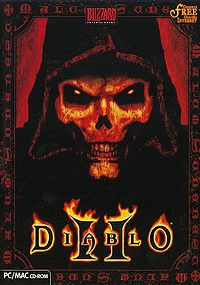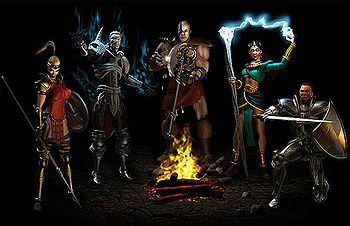- This is the article about the game Diablo II. Were you looking for game information or guides about Diablo II?
Diablo II is an ARPG game based in a dark fantasy setting developed by Blizzard North and released globally by Blizzard Entertainment on 29 June 2000.
The game is set in the fictional world of Sanctuary, centred around a group of anonymous heroes who are trying to catch up and stop the Prime Evil known as Diablo before he frees his brothers and destroys the mortal realm.
Diablo II was one of the most popular games of 2000. Major factors that contributed to Diablo II's success include its addictive gameplay and access to the free online play service, Battle.net.
The game was conceptualized and designed by David Brevik and Erich Schaefer, whom with Max Schaefer acted as Project Leads on the game. The main production roles were handled by Matthew Householder and Bill Roper.
An official expansion pack, entitled Diablo II: Lord of Destruction also developed by Blizzard North, was released on 29 June 2001. A sequel called Diablo III was announced to be in production on June 28, 2008 at WWI 2008 in Paris, but will be developed by Blizzard Entertainment, since Blizzard North has dissolved.
| Game [e] | |
|---|---|

| |
| Diablo II | |
| Developer(s): | Blizzard North |
| Publisher(s): | Windows/Mac NA: Blizzard EU: Sierra Entertainment Asia: HanbitSoft |
| Designer(s): | Erich Schaefer, Stieg Hedlund, David Brevik, Max Schaefer, Eric Sexton, Chase Clements |
| Composer(s): | Matt Uelmen |
| Series: | Diablo series |
| Genre(s): | ARPG |
| Release date(s): | 2000-06-29 |
| Platform(s): | PC/Mac |
| Engine: | 2D, inhouse |
| System requirements: | Windows PC Windows 95+, 233 MHz Pentium, 32 MB RAM, 650 MB HDD, DirectX compatible video card, 4X CD-ROM drive Mac OS G3 processor, 64 MB RAM plus virtual memory, System 8.1 or higher, 650 MB HDD, 4X CD-ROM drive, 256 colour display at 640x480 res (800x600 with exp) |
| Controls: | Mouse, Keyboard |
| Rating(s): | 15+ to 16+ |
| Score: | Unknown |
Contents
Gameplay
Diablo II is built around Acts that progresses the narrative story line of the game, with each act following a predetermined path and list of quests, with small selection of optional quests.
The player assumes the role of a hero from one of five different character classes, fighting monsters through wilderness areas and dungeons in order to level-up their character and gain better items. The game uses real-time combat and the player sees the character from an isometric viewpoint. Players also have the option of hiring one NPC hirelings that accompanies the player and attack nearby enemies. A powerful boss monster awaits the player at the end of each Act. Item drops, monster attributes, and most dungeon layouts are randomly-generated by Diablo II. The game also continues the use of randomised affixes from Diablo I.
After completing the four Acts in the game, there are two additional sequential difficulty levels, letting the player go through all three before reaching the max level at 99. These are: Normal, Nightmare, and Hell. On higher difficulties, monsters are stronger, experience is penalized on dying, and the player's resistances are handicapped. A character retains all abilities and items between difficulties, and may return to a lower difficulty at any time through a waypoint system.
Players can also create a hardcore character, as opposed to a normal (popularly called "softcore") character. A normal character can be resurrected if killed and resume playing, while a hardcore character has only one life. If killed, the character is permanently dead and unplayable, and all items and equipment on that character will be lost.
Character classes
Diablo II allows the player to choose between five different character classes: Amazon, Necromancer, Barbarian, Sorceress, and Paladin. Each character has different strengths and weaknesses and sets of skills to choose from, as well as varying beginning attributes.
- The Amazon hails from the islands of the Twin Seas, near the border of the Great Ocean. The class is based on Greek mythology Amazons. She is similar to the Rogue of Diablo I as they use ranged weaponry and use both strength and magic. The Amazon also uses javelins and spears. Many of her passive skills are defensive in nature, especially Dodge, Avoid, and Evade. The Amazon is voiced by Jessica Straus.
- The Necromancer is a death-themed caster, being Priests of Rathma from the Eastern jungles. His Summoning spells allow him raise skeletons, create golems, and resurrect dead monsters to fight alongside him. He also uses poison and "bone" skills, to cause damage to enemies. His Curses also afflict the enemy with debuffs. The Necromancer is voiced by Michael McConnohie.
- The Barbarian is a powerful melee fighter from the steppes of Mount Arreat. He is an expert at frontline combat, able to absorb great punishment like a "tank", and is the only class capable of dual-wielding weapons. His skills allow him to specialise in different types of weapons, increasing his resistances, speed, and defence. He can also use ancient Barbarian Warcries and combat techniques to buff himself and others as well as dealing with any foes quickly and violently. The Barbarian is voiced by David A. Thomas.
- The Sorceress hails from a rebellious mage clan of female-only Sorceresses who have wrested the secrets of magic use from the male-dominated clans. She wields the elements of ice, lightning and fire spells, using mostly offensive spells. Her Cold Skills can freeze enemies solid and bypass resistances, but do less damage than lightning or fire. The Sorceress's Teleport spell allows her to instantly travel to a new destination, making her very difficult to hit. As such she is a "glass cannon", dealing much damage, but can't take much in turn. The Sorceress is voiced by Liana Young.
- The Paladin is a crusader from the Church of Zakarum, fighting for the glory of the Light. The Paladin's combat skills range from fanatical attacks to heavenly thunderbolts and blessed auras. The auras can incre damage, or resist magic attacks, or boosting defence. The Paladin's auras will buff all party members, making him very useful for multiplayer. The shield is another Paladin speciality, and he is the only character that can use it as a weapon. The Paladin also have very powerful anti-undead skills. The Paladin is voiced by Larry B. Scott.
Monsters and Items
The monsters of Diablo II are more numerous than the ones in Diablo I, and has slightly more abilities of their own, but is otherwise quite similar in style of gameplay. Some monsters have received improved AI, like the Fallen monsters, who attack slightly more coordinated, and ranged monsters who retreat if the player moves up to melee range. A few boss encounters also use more "intelligent" combat, like special abilities from the boss, rather than the fight just being a race to drink potions.
The potions work similarly to the original. It's gameplay purpose is basically that of an extended health/mana bar, with no cooldowns on usage, and little delay in filling up the resource pools. The big change is how the belt works, where instead of 1-0 selected slots, the player now only has 4 slots, but as he levels up, he can get better belts, which can save more rows of 4 potions, making the actual maximum of stored potions up to 16. Scrolls can not be stored in the Diablo II belt, but specific "tome" items that takes up 2 slots can be purchased to save space, storing up to 20 scrolls in each.
Items use a very similar mechanic to the original game, with affixes on magical items, an uniques that are more powerful. On top of that, set items and rares were introduced. Basically better versions of magical items, but not as special as uniques.
Multiplayer
Diablo II can be played multiplayer over or Blizzard's free online service Battle.net. Unlike the original Diablo I, Diablo II was made specifically with online gaming in mind. Several spells (such as auras or Warcries) multiply their effectiveness if they are cast within a party and the game world included a lot more open spaces.
The Diablo II Battle.net is divided into "Open" and "Closed" realms. Players may play their single-player characters on open realms while characters in closed realms are stored on the servers as a measure against hacking and cheating. The character must also be played every 90 days to avoid expiration. Online play is otherwise nearly identical to single-player play. The most notable difference is that online maps are generated randomly every time a new game is entered, while offline single player maps are just generated when the game is first started as a persistent world the player will always return to when playing with that character.
The game is most often played cooperatively (PvM), and the right class combination with complementary skills can finish some of the game's climactic battles in a matter of seconds, providing strong incentives for party-oriented character builds. Up to eight players can be in one game but are not automatically made into a party. It's also possible to form multiple opposing parties. Experience gained, monsters' hit points and damage, and the number of items dropped are all increased as more players join a game, though not in a strictly proportional manner. Players are allowed to duel each other with all damage being reduced in PvP. The bounty for a successful kill in PvP is a portion of the gold and the "ear" of the defeated player (with the previous owner's name and level at the time of the kill).
Due to the PvP mechanics, the game has a lot of non-consensual PvP combat, also called "Player Killing", PK.
Patch 1.10 included the option of playing with a ladder character. The ladder system can be reset at various intervals to allow for all players to start fresh with new characters on an equal footing. Ladder seasons have lasted from as short as nine months to over a year. When a ladder season ends all ladder characters are transferred to the non-ladder population. Certain rare items are available only within ladder games, although they can be traded for and exchanged on non-ladder after the season has ended.
The game has been patched extensively; the precise number of patches is impossible to determine as Battle.net has the capability of making minor server-side patches to address immediate issues. The game is currently in version 1.12 with the latest major patch released on June 17, 2008. Through the patch history, several exploits and issues have been addressed (such as illegal item duplication, though it still exists), as well as major revamps to the game's balance. Not all patches have affected Diablo II directly, as several were designed to address issues in the expansion to the game and had minimal effects on Diablo II.
On March 3, 2009, Blizzard announced a new Diablo 2 content patch, 9 years after the game's release. Diablo 2 content patch 1.13 has been released on a public test server named "classic beta".
Synopsis
3 Versions and expansion pack 3.1 Spawn 3.2 PlayStation 3.3 Expansion 3.4 Re-releases 4 Resources
Reference
| Blizzard Entertainment & other Game-related Topics [e] Blizz Games Other Games Terms Devs Blizz ppl D3 D2 D1 Other ppl Events Merchandise Related |
|---|
| Blizzard's Games |
|
|---|
| Game Developers |
|---|
| Blizzard People |
Blizzard's Top |
Blizzard All |
Blizzard All cont. |
Ex-Blizzard |
|---|
| Diablo II Team |
|---|
| Diablo I Team |
|---|
| Industry People |
|---|
| Diablo Merchandise |
|
|
|
|
|---|
